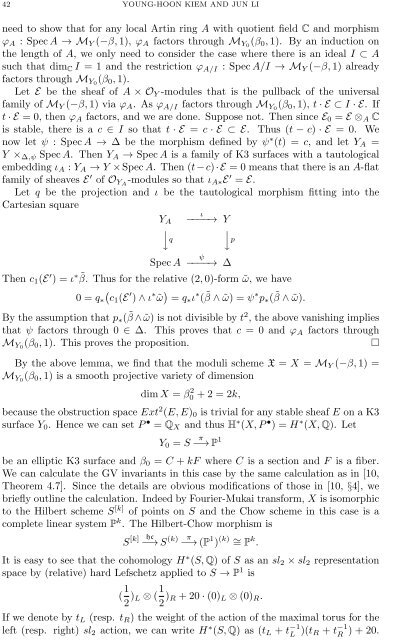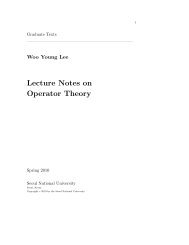Categorification of Donaldson-Thomas invariants via perverse ...
Categorification of Donaldson-Thomas invariants via perverse ...
Categorification of Donaldson-Thomas invariants via perverse ...
Create successful ePaper yourself
Turn your PDF publications into a flip-book with our unique Google optimized e-Paper software.
42 YOUNG-HOON KIEM AND JUN LIneed to show that for any local Artin ring A with quotient field C and morphismϕ A : Spec A → M Y (−β, 1), ϕ A factors through M Y0 (β 0 , 1). By an induction onthe length <strong>of</strong> A, we only need to consider the case where there is an ideal I ⊂ Asuch that dim C I = 1 and the restriction ϕ A/I : Spec A/I → M Y (−β, 1) alreadyfactors through M Y0 (β 0 , 1).Let E be the sheaf <strong>of</strong> A × O Y -modules that is the pullback <strong>of</strong> the universalfamily <strong>of</strong> M Y (−β, 1) <strong>via</strong> ϕ A . As ϕ A/I factors through M Y0 (β 0 , 1), t · E ⊂ I · E. Ift · E = 0, then ϕ A factors, and we are done. Suppose not. Then since E 0 = E ⊗ A Cis stable, there is a c ∈ I so that t · E = c · E ⊂ E. Thus (t − c) · E = 0. Wenow let ψ : Spec A → ∆ be the morphism defined by ψ ∗ (t) = c, and let Y A =Y × ∆,ψ Spec A. Then Y A → Spec A is a family <strong>of</strong> K3 surfaces with a tautologicalembedding ι A : Y A → Y ×Spec A. Then (t−c)·E = 0 means that there is an A-flatfamily <strong>of</strong> sheaves E ′ <strong>of</strong> O YA -modules so that ι A∗ E ′ = E.Let q be the projection and ι be the tautological morphism fitting into theCartesian squareY A⏐↓ qSpec Aι−−−−→ Y⏐ ⏐↓pψ−−−−→ ∆Then c 1 (E ′ ) = ι ∗ ˜β. Thus for the relative (2, 0)-form ˜ω, we have0 = q ∗(c1 (E ′ ) ∧ ι ∗ ˜ω ) = q ∗ ι ∗ ( ˜β ∧ ˜ω) = ψ ∗ p ∗ ( ˜β ∧ ˜ω).By the assumption that p ∗ ( ˜β ∧ ˜ω) is not divisible by t 2 , the above vanishing impliesthat ψ factors through 0 ∈ ∆. This proves that c = 0 and ϕ A factors throughM Y0 (β 0 , 1). This proves the proposition.□By the above lemma, we find that the moduli scheme X = X = M Y (−β, 1) =M Y0 (β 0 , 1) is a smooth projective variety <strong>of</strong> dimensiondim X = β 2 0 + 2 = 2k,because the obstruction space Ext 2 (E, E) 0 is tri<strong>via</strong>l for any stable sheaf E on a K3surface Y 0 . Hence we can set P • = Q X and thus H ∗ (X, P • ) = H ∗ (X, Q). LetπY 0 = S −→ P 1be an elliptic K3 surface and β 0 = C + kF where C is a section and F is a fiber.We can calculate the GV <strong>invariants</strong> in this case by the same calculation as in [10,Theorem 4.7]. Since the details are obvious modifications <strong>of</strong> those in [10, §4], webriefly outline the calculation. Indeed by Fourier-Mukai transform, X is isomorphicto the Hilbert scheme S [k] <strong>of</strong> points on S and the Chow scheme in this case is acomplete linear system P k . The Hilbert-Chow morphism isS [k]hcπ−→ S (k) −→ (P 1 ) (k) ∼ = P k .It is easy to see that the cohomology H ∗ (S, Q) <strong>of</strong> S as an sl 2 × sl 2 representationspace by (relative) hard Lefschetz applied to S → P 1 is( 1 2 ) L ⊗ ( 1 2 ) R + 20 · (0) L ⊗ (0) R .If we denote by t L (resp. t R ) the weight <strong>of</strong> the action <strong>of</strong> the maximal torus for theleft (resp. right) sl 2 action, we can write H ∗ (S, Q) as (t L + t −1L )(t R + t −1R ) + 20.













